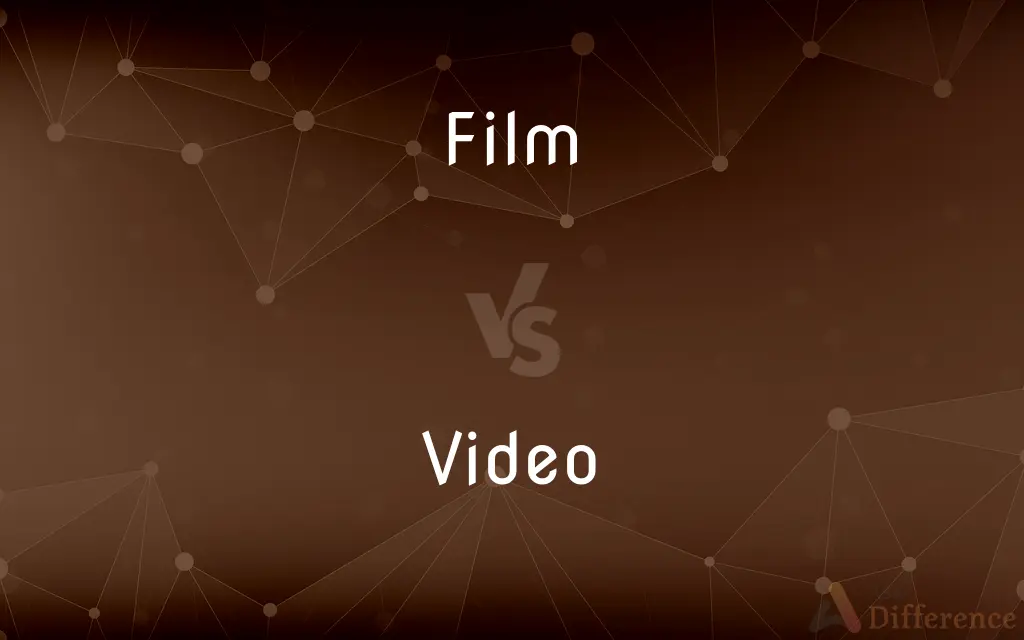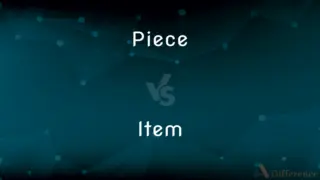Film vs. Video — What's the Difference?
By Tayyaba Rehman & Fiza Rafique — Updated on April 18, 2024
Film refers to motion pictures shot on photographic film, typically offering richer visuals, while video denotes recordings on electronic media, prioritizing convenience and accessibility.

Difference Between Film and Video
Table of Contents
ADVERTISEMENT
Key Differences
Film is traditionally captured on celluloid reels which require chemical processing to develop images, offering a high-quality aesthetic with distinctive grain and color depth. Video, on the other hand, captures images electronically, making it easier to edit and distribute but often at the cost of lower resolution and dynamic range.
The process of filmmaking is generally more costly and time-consuming, involving intricate production techniques and expensive equipment. Video production, whereas, benefits from digital technology, allowing for quicker setups and cost-effective solutions, making it ideal for a wide range of uses from broadcasting to personal recording.
Films are usually associated with cinematic releases and are often crafted for artistic or commercial viewing in theaters. Videos, on the other hand, cover a broader spectrum including television broadcasts, online streaming, and personal recordings, fitting various formats and purposes.
The audience experience for films is typically centered around immersive environments like movie theaters that emphasize detailed visuals and sound. Conversely, videos are consumed across diverse platforms and devices, prioritizing convenience and accessibility over the immersive experience.
The longevity and preservation of film can be superior due to the archival qualities of film stock, which, if properly stored, can last for decades. Videos, however, depend on the durability and backward compatibility of digital storage media, which may pose challenges in long-term preservation.
ADVERTISEMENT
Comparison Chart
Medium
Photographic film
Electronic media
Production Cost
Higher, due to material and process
Lower, with digital technology
Distribution
Theatrical releases, DVD, Blu-ray
TV, online streaming, DVDs
Image Quality
Higher resolution, color depth
More variable, often lower
Preservation
Long-term archival potential
Dependent on digital formats
Compare with Definitions
Film
A series of still images on celluloid, projected to create the illusion of motion.
The film was shown in cinemas across the country.
Video
Recordings made with digital cameras or camcorders, stored in electronic formats.
The video was uploaded to the internet immediately.
Film
A traditional method of movie-making using photographic techniques.
They still shoot the movie on film to achieve a classic look.
Video
A tool for personal, educational, or commercial use due to its versatility and ease of distribution.
They created a video tutorial for the online course.
Film
An entertainment form that often aims for high production values and artistic expression.
The film festival features works from internationally renowned filmmakers.
Video
Often used for instant communication, as in video calls and conferences.
The team uses video conferencing to discuss projects.
Film
A storytelling medium known for its artistic and commercial value in cinema.
The director's new film received critical acclaim.
Video
A format widely used for media consumption on televisions and the internet.
Streaming video has become a popular way to watch series and movies.
Film
A medium for recording visual content for archival and projection purposes.
Classic films are often restored to preserve their original quality.
Video
A medium that has revolutionized the way content is created and shared globally.
Video blogs have become a powerful platform for individual expression.
Film
A film, also called a movie, motion picture or moving picture, is a work of visual art used to simulate experiences that communicate ideas, stories, perceptions, feelings, beauty, or atmosphere through the use of moving images. These images are generally accompanied by sound, and more rarely, other sensory stimulations.
Video
Video is an electronic medium for the recording, copying, playback, broadcasting, and display of moving visual media. Video was first developed for mechanical television systems, which were quickly replaced by cathode ray tube (CRT) systems which were later replaced by flat panel displays of several types.
Film
A thin skin or membrane.
Video
A sequence of images processed electronically into an analog or digital format and displayed on a screen with sufficient rapidity as to create the illusion of motion and continuity.
Film
A thin, opaque, abnormal coating on the cornea of the eye.
Video
A signal carrying such images.
Film
A thin covering or coating
A film of dust on the piano.
Video
A movie recorded electronically, usually including a soundtrack
A video of a birthday party.
Film
A thin, flexible, transparent sheet, as of plastic, used in wrapping or packaging.
Video
The presentation of such a work.
Film
A thin sheet or strip of flexible material, such as a cellulose derivative or a thermoplastic resin, coated with a photosensitive emulsion and used to make photographic negatives or transparencies.
Video
The electronic medium in which such movies are recorded
A movie released on video.
Film
A thin sheet or strip of developed photographic negatives or transparencies.
Video
A music video.
Film
A movie, especially one recorded on film.
Video
Television, television show, movie.
Film
The presentation of such a work.
Video
A short film clip, with or without audio (as in a music video, or one of the plethora of user-generated short movies on sites such as YouTube).
We made a video montage of Robbie for his fiftieth birthday.
Check out my new videos on YouTube.
Film
A long, narrative movie.
Video
Motion picture stored on VHS or some other format.
Film
Movies collectively, especially when considered as an art form.
Video
(dated) VHS.
Film
To cover with or as if with a film.
Video
(Britain) To record using a video camera, to videotape
Film
To record on film or video using a movie camera
Film a rocket launch.
Film a scene from a ballet.
Video
(Britain) To record a television program
Film
To become coated or obscured with or as if with a film
The window filmed over with moisture.
Video
(ambitransitive) To visually record (activity, or a motion picture) in general, with or without sound.
Film
To make or shoot scenes for a movie.
Video
The visible part of a television transmission;
They could still receive the sound but the picture was gone
Film
A thin layer of some substance; a pellicle; a membranous covering, causing opacity.
A clear plastic film for wrapping food
Video
A recording of both the video and audio components (especially one containing a recording of a movie or television program)
Film
(photography) A medium used to capture images in a camera.
Video
Broadcasting visual images of stationary or moving objects;
She is a star of screen and video
Television is a medium because it is neither rare nor well done
Film
A movie.
Film
Cinema; movies as a group.
Film
A slender thread, such as that of a cobweb.
Film
(ambitransitive) To record (activity, or a motion picture) on photographic film.
A Hollywood studio was filming on location in NYC.
I tried to film the UFO as it passed overhead.
Film
(ambitransitive) To visually record (activity, or a motion picture) in general, with or without sound.
Film
(transitive) To cover or become covered with a thin skin or pellicle.
Film
A thin skin; a pellicle; a membranous covering, causing opacity.
He from thick films shall purge the visual ray.
Film
Hence, any thin layer covering a surface.
Film
A slender thread, as that of a cobweb.
Her whip of cricket's bone, the lash of film.
Film
The layer, usually of gelatin or collodion, containing the sensitive salts of photographic plates.
Film
A flexible sheet of celluloid or other plastic material to which a light-sensitive layer has been applied, used for recording images by the processes of photography. It is commonly used in rolls mounted within light-proof canisters suitable for simple insertion into cameras designed for such canisters. On such rolls, varying numbers of photographs may be taken before the canister needs to be replaced.
Film
A motion picture.
Film
The art of making motion pictures; - used mostly in the phrase the film.
Film
A thin transparent sheet of plastic, used for wrapping objects; as, polyethylene film.
Film
To cover with a thin skin or pellicle.
It will but skin and film the ulcerous place.
Film
To make a motion picture of (any event or literary work); to record with a movie camera; as, to film the inauguration ceremony; to film Dostoevsky's War and Peace.
Film
A form of entertainment that enacts a story by a sequence of images giving the illusion of continuous movement;
They went to a movie every Saturday night
The film was shot on location
Film
A medium that disseminates moving pictures;
Theater pieces transferred to celluloid
This story would be good cinema
Film coverage of sporting events
Film
A thin coating or layer;
The table was covered with a film of dust
Film
A thin sheet of (usually plastic and usually transparent) material used to wrap or cover things
Film
Photographic material consisting of a base of celluloid covered with a photographic emulsion; used to make negatives or transparencies
Film
Make a film or photograph of something;
Take a scene
Shoot a movie
Film
Record in film;
The coronation was filmed
Common Curiosities
What is the main difference between film and video?
Film is shot on celluloid and requires development, while video is recorded electronically and can be viewed instantly.
How has video affected the consumption of media?
Video has made media more accessible and versatile, allowing for instant viewing and sharing across multiple platforms.
Can video achieve the same quality as film?
Video can approach film quality with advanced technology, but film generally offers superior resolution and color depth.
Why is film considered better for cinematic releases?
Film captures richer visuals and audio, making it preferred for the immersive cinema experience.
What are the preservation challenges for video compared to film?
Video faces challenges in long-term data integrity and format obsolescence, whereas film, if stored properly, can last for many years.
How do the costs of producing and distributing film compare to those of video?
Producing and distributing film is generally more expensive due to the costs of film stock and processing. Video, being digital, cuts down on these costs significantly, making it cheaper and easier to distribute, particularly through digital channels like streaming services.
What role has digital technology played in the evolution of video production?
Digital technology has revolutionized video production by reducing costs, simplifying editing processes, and enabling high-definition quality, which has made video production more accessible to a wider range of creators.
How does the production process differ between film and video?
The production process for film involves shooting on physical film stock and chemical development, making it more complex and costly. Video production uses digital cameras and immediate electronic processing, facilitating faster and often less expensive production cycles.
Are there specific genres or types of content better suited to film or video?
Epic and high-budget movies often utilize film to leverage its visual and auditory quality, while video is more suited to documentaries, news, and personal content due to its flexibility and ease of use.
In what ways has the audience's viewing experience evolved with the transition from film to video?
The audience's viewing experience has become more flexible and personalized with video, allowing viewers to access content on various devices at their convenience. Film, while offering a unique, high-quality viewing experience, is less adaptable to various viewing contexts than video.
Share Your Discovery

Previous Comparison
Piece vs. Item
Next Comparison
Just vs. ExactlyAuthor Spotlight
Written by
Tayyaba RehmanTayyaba Rehman is a distinguished writer, currently serving as a primary contributor to askdifference.com. As a researcher in semantics and etymology, Tayyaba's passion for the complexity of languages and their distinctions has found a perfect home on the platform. Tayyaba delves into the intricacies of language, distinguishing between commonly confused words and phrases, thereby providing clarity for readers worldwide.
Co-written by
Fiza RafiqueFiza Rafique is a skilled content writer at AskDifference.com, where she meticulously refines and enhances written pieces. Drawing from her vast editorial expertise, Fiza ensures clarity, accuracy, and precision in every article. Passionate about language, she continually seeks to elevate the quality of content for readers worldwide.















































